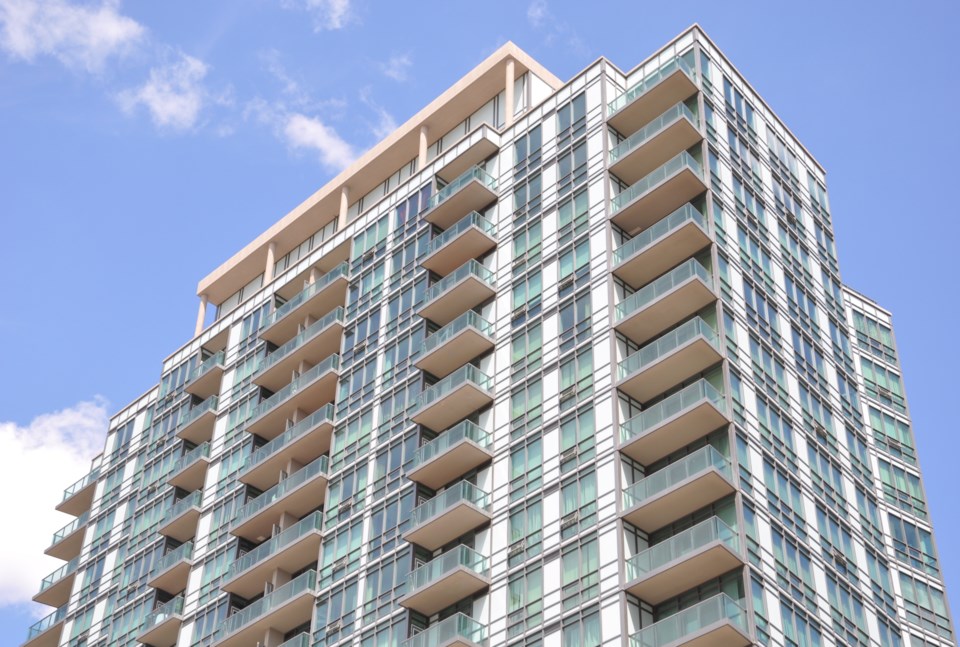Plans for a 500+ unit apartment building on the southwest corner of Wellington and Leslie streets hit a significant roadblock at council last week after lawmakers voted down the proposal.
Although proponents of the high-density apartment building, which would bring 519 units to the community, along with 12 townhouse blocks for a total of 59 units, can still appeal council’s decision to the Ontario Land Tribunal, council’s decision said they believed what was before them was an inappropriate use of the land.
Adena Meadows resident Alan Benlolo was one of several neighbours to speak against the proposal at last Tuesday’s public planning meeting. While he said he was glad to potentially see the end of an “ugly, unkempt field” on Wellington Street, what was up for council’s decision could spell the “end” of Aurora as we know it.
“The need for housing grows… and over the years I have watched both sides of Wellington Street between Bayview Avenue and Leslie Street get developed – it’s going on as we speak at the corner of Wellington Street and Stronach Boulevard, which I am glad to see, he said. “Most importantly, they have been developed into single-detached homes and stacked towns, not apartment buildings.
“I moved to Aurora from Thornhill for a bigger piece of land in a less dense town. I have built my house on a two-acre parcel of land and like all of the homes in the Adena Meadows community just south of the proposal, are all on two acres of land – one house per two acres. My obvious concern is apartment buildings do not fit into this part of Aurora, as well as the number of units per acre. Three to four units per acre, I believe… this current site is about 10 acres developable with approximately 650 units, so by my calculation I think 80 to 90 per hectare.
“If this proposal goes through and they’re able to build a seven-storey apartment building at Wellington and Leslie, Aurora is finished.”
From the perspective of environmental advocate Wendy Kenyon, should the proposal go ahead, it won’t only be Aurora that is “finished.”
“I am not against development; I am, however, against the loss of balance between development and the need to respect and protect our natural environment and its boundaries,” said Kenyon. “I am seeing what is now happening on the Shining Hill lands on St. John’s Sideroad West and believe that Aurora has already lost that critical balance.
"According to the applicant’s environmental report, the 1289 Wellington proposal includes direct loss of over 5,000 square metres… the removal of 33,000 square metres of cultural meadow where species at risk, monarch butterflies, are confirmed as present. A Municipal OP requires there will be no negative impacts to the natural heritage features or their ecological functions. Yet the environmental report is unable to demonstrate this, concluding ‘Overall, the proposed development is not expected to have a negative impact on the natural features or their ecological functions.’ In my opinion, that is simply not sufficient to comply with the explicit wording and intent of regulation.
“Pages and pages of environmental report are dedicated to mitigation measures, restoration and so on, and that is great, but there is an underlying premise that disturbance and removal of natural features can be compensated. But the reality is you’re still taking away immediate habitat, removing trees that are already providing a service, pushing a development with all its inherent risks, very close to the watercourse. Despite efforts, ecosystems often don’t recover from this level of assault, particularly as the lands become further urbanized. The proposed development exists only on paper whereas the environmental features are already living and providing a service to this community. So, I am asking, can we not do more to preserve them? I believe we can and it all comes down to a question of balance.”
Other residents said it was “unconscionable” to put that amount of density in the location proposed, stating that the Yonge Street corridor, complete with transit, would make more sense, worries about noise pollution and traffic in an already busy corridor, and the loss of Aurora’s “small-town feel.”
Council members largely agreed, voting down the proposal due to its encroachment on environmental features, “inappropriate” density, impacts on species of concern, and the regional conversion of this site from employment land to allow it to be developed as proposed.
“It’s just so densified,” said Councillor Sandra Humfryes before council voted down the plan while still considering sending the matter to a further public planning meeting. “There are a lot of areas for improvement for the next public planning meeting we hope to see coming forward.”
Councillor Michael Thompson said he did not support the density and was concerned with the proposed building’s massing and “overall height.”
“I would like to see some notable changes,” he said, specifically citing the need for a park within the plan’s area.
A win-win, Councillor Harold Kim mentioned, occurs when a community works with the developer to find a solution that works.
“There should have been some consultation [with the surrounding residents],” said Councillor Kim. “It would be great to have two parties have some communication.”
Added Mayor Mrakas: “What can we put in an area that benefits the community so we’re doing what is best for our community? That takes all parties working together. Those concerns are there, so let’s see if we can work on this and where we can go from there.”
Brock Weir, Local Journalism Initiative reporter, The Auroran


